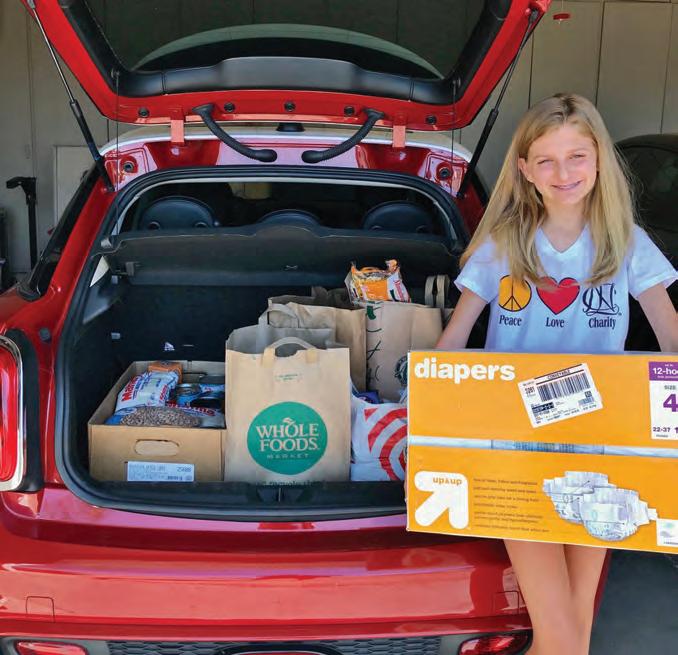
4 minute read
SAME MISSION. DONE DIFFERENTLY.
An overview of St. Vincent de Paul’s response to COVID-19 from the pandemic’s earliest days in Arizona to now
By Marisol Saldivar
Advertisement
It felt surreal how quickly COVID-19 (the novel coronavirus) went from a faraway threat to a tangible risk at St. Vincent de Paul. The pandemic would change everything, but one thing remained certain — commitment to continuing critical services to the Valley’s most vulnerable and those who would find themselves in need like never before.
A sudden and necessary shift
March 16 marked the official pivot of SVdP’s in-person service model to one that followed social distancing and COVID-19 health safety guidelines set by local and federal governments.
Just days prior, volunteers arrived for kitchen meal prep, guests filled every chair of the Resource Center for people experiencing homelessness, hundreds ate breakfast together around tables at the Phoenix Dining Room and patients checked in for appointments at SVdP’s Virginia G. Piper Medical & Dental Clinic.
But within 48 hours all of that changed as public health officials confirmed community spread in Maricopa County. SVdP leadership took quick action and an extremely nimble staff implemented all-new pandemic procedures.
“It’s a challenge because our entire model is built upon being close to people,” CEO Steve Zabilski told the Arizona Republic for a column that week. “We bring in hundreds of volunteers every day… we do just the opposite of what is being asked — we do social embracing — but we had to go from social embracing to social distancing in a matter of hours.”
On-site staff was greatly limited, with some staff members shifting to remote work where possible. All volunteers were asked to remain home for their safety and to help limit possible exposure or spread. Daily sanitization, frequent hand washing and maintaining social distance became policy.
Services looked drastically different:
SVdP’s five dining rooms shifted to grab-and-go meals. The Medical Clinic practiced telehealth. The Dental Clinic took emergency cases only and had staff redeployed to the kitchen. Ozanam Manor (the transitional shelter) isolated as much as possible. The Resource Center offered to-go hygiene kits, food and water for people experiencing homelessness. Rent and utility assistance happened remotely over the phone. Home visits took place outside with food boxes delivered to doorsteps. The Dream Center provided take-home activity kits for children. The Urban Farm harvested and packed fresh produce to accompany to-go meals.

A guest experiencing food insecurity hugs the grocery bags SVdP delivered to his home one early Saturday morning. Getting food to doorsteps is one of the many ways SVdP kept critical services flowing throughout the pandemic.

Dream Center Supervisor Cindy Bernardo, offers to-go meals to families through a drive-thru window that was always part of the structure, but never activated like this until the Family Dining Room and supplemental education Dream Center needed a safe and efficient way to continue meal service and take-home activity kits for children.

Maintenance staff member Rosa Lugo helps pack thousands of sack lunches in some of SVdP’s earliest days of the response.
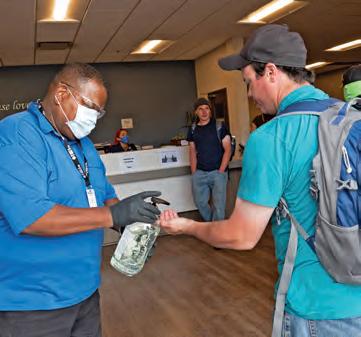
Resource Center Support Specialist Ronnie Smith sanitizes the hands of every guest experiencing homelessness who enters the center, which now also offers masks to guests.
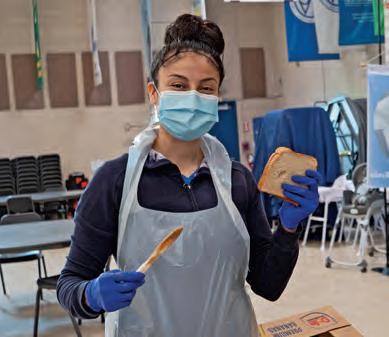
Dental Clinic staff like Betty Contreras were redeployed to help make 4,000 peanut butter sandwiches every day. The Dental Clinic saw emergency cases only for two months until reopening to existing patients later in the year.
Every day saw new challenges and additional shifting as the community at large learned more about the virus. By March 30, SVdP required masks and shortly thereafter had mandatory temperature checks before entering any location.
Finding silver linings all around
The daily unpredictability felt taxing, but along patterns and colors arrived in the mail. with the challenges came creativity and resilience. The Help from Home program was born, “In the midst of chaos offering volunteers projects they could complete for SVdP from the comfort and safety of home. (Meet virtual volunteers. See pages 17-18.)
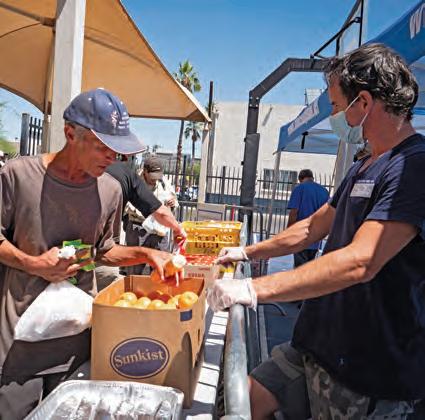
A donation of fresh oranges from a local grocer helped bring some vitamin C to guests relying on SVdP’s grab-and-go meal services at all five dining rooms across the Valley, including the downtown Phoenix Dining Room pictured here.
An outpouring of love, donations and unique opportunities came from the community resulting in the launch of multiple restaurant partnerships and the joining of forces with CVS Health to offer COVID-19 testing in SVdP’s Medical Clinic. The #AllinThisTogether movement at SVdP took off and challenged people to #MakeKindnessViral. Stories of donated stimulus checks circulated. Notes of positivity poured in for shelter residents, who remained mostly isolated. Homemade masks in all patterns and colors arrived in the mail.
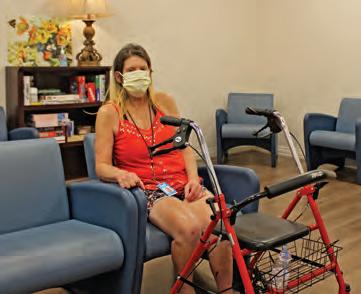
Inside SVdP’s transitional shelter, Ozanam Manor, residents isolated as much as possible and successfully went without any COVID-19 cases for seven months.
-- Associate CEO Shannon Clancy
A daily reality and the flood to come
By summer, SVdP settled into a “new normal” with social distancing procedures becoming routine. Response became less about addressing the on-going virus and more about tackling challenges — like a summer of record-breaking heat — atop the daily COVID-19 lifestyle.
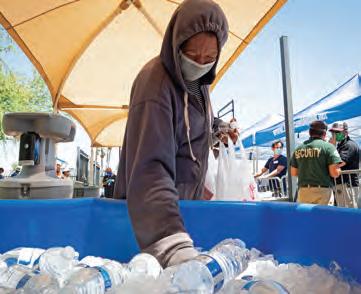
Water relief and donations were more critical than ever this year, as SVdP tackled two crises at once (summer heat and COVID-19). Unable to bring as many people inside, SVdP erected outdoor heat relief and water stations with shade structures and swamp coolers.
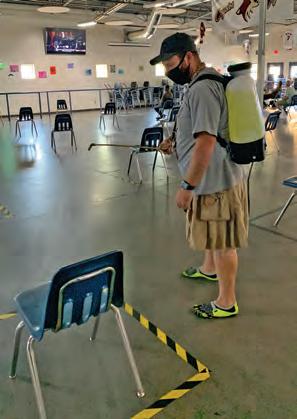
Former Phoenix Dining Room Manager Bobby Plattner uses a high-tech sanitizing backpack to disinfect chairs and spaces after a night of hosting a weather relief shelter for 80 guests experiencing homelessness. Social distancing limits the typically 250-person temporary shelter inside the dining room.
Then, the COVID-19 response took a new form as thousands of families, who lost jobs in the pandemic, suddenly found themselves unable to pay bills and at risk of eviction. Hundreds of calls poured into SVdP’s rent and utility assistance line, almost all facing months without an income and a pile of unpaid bills.
An extended state and federal eviction moratorium, along with generous funding from both the community and government, is helping keep families in their homes… at least until the end of 2020.
But as the pandemic wears on and many jobs remain on hold or lost all together, more and more families find themselves caught in the economic fallout and slipping into crushing debt.
“We foresee a very challenging situation ahead,” Shannon said. “One where we don’t have a sufficient safety net even with recent extensions and funding to help all the families already turning to us for assistance.”
Here is where SVdP finds itself in its COVID-19 response, caught in the eye of the storm yet still moving forward, eyes fixed ahead. Like it did in the spring, SVdP will commit again to supporting and embracing those who seek help and hope.
Read more about bill assistance during COVID-19 and meet a family SVdP helped remain in their home. See page 12.



